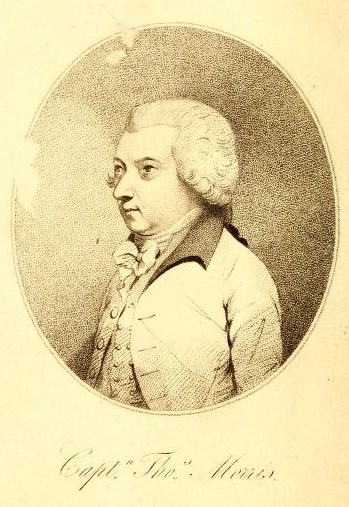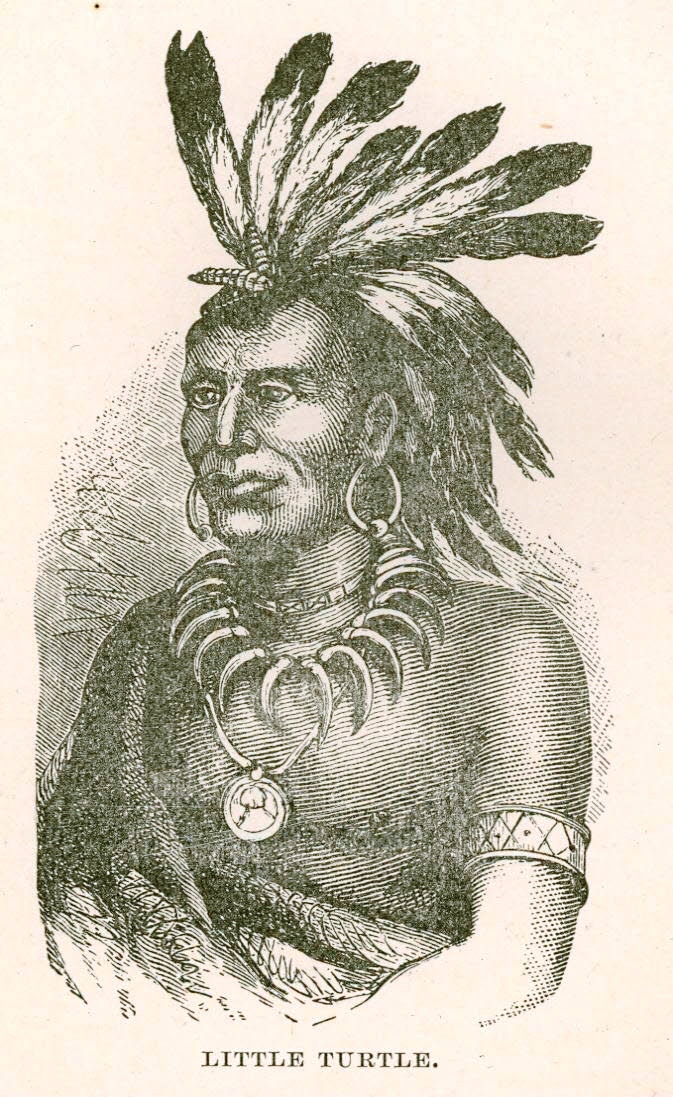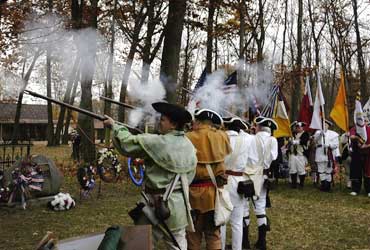|
Pacanne
Pacanne (c. 1737–1816) was a leading Miami chief during the late 18th and early 19th centuries. Son of The Turtle (Aquenackqua), he was the brother of Tacumwah, who was the mother of Chief Jean Baptiste Richardville. Their family owned and controlled the Long Portage, an 8-mile strip of land between the Maumee and Wabash Rivers used by traders travelling between Canada and Louisiana. As such, they were one of the most influential families of Kekionga. Pacanne (P'Koum-Kwa) was probably the nephew of Cold Foot, the Miami Chief of Kekionga until a smallpox epidemic took his life in 1752. One of the earliest references to Pacanne comes from Captain Thomas Morris, who had been sent by the British to secure Kekionga, Ouiatenon, Vincennes, and Kaskaskia following Pontiac's Rebellion. In 1764, at Fort Miamis, near Kekionga, two Miami warriors dragged him to the village and tied him to a pole with the intent of executing him. According to his report, Pacanne, still a minor, ro ... [...More Info...] [...Related Items...] OR: [Wikipedia] [Google] [Baidu] |
Pacanne
Pacanne (c. 1737–1816) was a leading Miami chief during the late 18th and early 19th centuries. Son of The Turtle (Aquenackqua), he was the brother of Tacumwah, who was the mother of Chief Jean Baptiste Richardville. Their family owned and controlled the Long Portage, an 8-mile strip of land between the Maumee and Wabash Rivers used by traders travelling between Canada and Louisiana. As such, they were one of the most influential families of Kekionga. Pacanne (P'Koum-Kwa) was probably the nephew of Cold Foot, the Miami Chief of Kekionga until a smallpox epidemic took his life in 1752. One of the earliest references to Pacanne comes from Captain Thomas Morris, who had been sent by the British to secure Kekionga, Ouiatenon, Vincennes, and Kaskaskia following Pontiac's Rebellion. In 1764, at Fort Miamis, near Kekionga, two Miami warriors dragged him to the village and tied him to a pole with the intent of executing him. According to his report, Pacanne, still a minor, ro ... [...More Info...] [...Related Items...] OR: [Wikipedia] [Google] [Baidu] |
Tacumwah
Tacumwah (c. 1720 – c. 1790), alternate spelling "Taucumwah", aka Marie-Louise Pacanne Richerville (Richardville), was a businesswoman and prominent chieftess of the Miami tribe. She was the sister of Pacanne, a leading Miami chief, and the mother of Chief Jean Baptiste Richardville (or "Peshewa"). The name Tacumwah means "Parakeet" in the Miami language. Tacumwah married Antoine Joseph Drouet de Richardville, the son of a French nobleman who was serving as a lieutenant in the French garrison at Fort St. Phillipe, later Fort Miamis. Richerville—who later Anglicized his name as Richardville, the form in which he passed the name to his son—later left the area and became a fur trader in Canada. Tacumwah had three other children. They were all baptised in 1773 by Father Pierre Gibault, but Tacumwah divorced Richerville a year later when he sided with Alexander and Francis Maisonville for control of the Long Portage, an 8-mile strip of land between the Maumee and Wabash Ri ... [...More Info...] [...Related Items...] OR: [Wikipedia] [Google] [Baidu] |
Jean Baptiste Richardville
Jean Baptiste de Richardville ( 1761 – 13 August 1841), also known as or in the Miami-Illinois language (meaning 'Wildcat' or 'Lynx') or John Richardville in English language, English, was the last 'civil tribal chief, chief' of the Miami people. He began his career in the 1790s as a fur trader who controlled an important portage connecting the Maumee River to the Little River (Indiana), Little River (the present-day Little Wabash River) in what became the present-day state of Indiana. Richardville emerged a principal chief in 1816 and remained a leader of the Miamis until his death in 1841. He was a signatory to the Treaty of Greenville (1795), as well as several later treaties between the U.S. government and the Miami people, most notably the Treaty of Fort Wayne (1803), the Treaty of Fort Wayne (1809), the Treaty of St. Mary's (1818), Treaty of Saint Mary's (1818), the Treaty of Mississinewas (1826), the treaty signed at the Forks of the Wabash (1838), and the Treaty of the ... [...More Info...] [...Related Items...] OR: [Wikipedia] [Google] [Baidu] |
Le Gris
Nagohquangogh (''Le Gris''), was a chief of the Pepikokia band of the Miami tribe in the 18th century. Also known as ''The Gray'', he was one of three important Miami leaders during the Northwest Indian War, along with Pacanne and Little Turtle. In 1752, a smallpox epidemic hit many Miami villages. Charles le Moyne, Sieur de Longueil wrote of it to the minister of colonial affairs in France, and noted that Chief Coldfoot and his sons were dead, as was "Le Gris, Chief of the Tepicons," who was "well disposed towards the French." The ''Le Gris'' he wrote of was probably an elder relative of the subject of this article, who was born ''Waspikingua'', became ''Nagohquangogh'', and is sometimes referred to as ''Le Petit Gris'' to distinguish himself from the former chief. During the Winter of 1824–25, Miami Chief Le Gros shared some Miami history with C. C. Trowbridge. He referred to an "old woman and her son" who survived a smallpox epidemic on the Tippecanoe River and came to th ... [...More Info...] [...Related Items...] OR: [Wikipedia] [Google] [Baidu] |
Thomas Morris (British Army Officer)
Thomas Morris (1732?–1808) was a British Army officer and writer. Early life Born at Carlisle, where he was baptised on 22 April 1732, he was one of four sons of Captain Thomas Morris, soldier author of the popular song ''Kitty Crowder'', who died about 1752. Charles Morris the songwriter and poet was his brother. Morris entered Winchester College as a scholar in 1741. After time in tuition in London, joined the 17th Foot, which was his father's regiment, at Kinsale, in 1748. In 1753 he took leave and spent time in Paris, giving him a command of the French language. American service In 1757 Morris shipped with his regiment for the Americas. He was at Canajoharie in 1761, from where he wrote to his good friend Richard Montgomery. Morris spent time in Martinique, the 17th Regiment having taken part in the Invasion of Martinique (1762) under Robert Monckton, and served at the siege of Havana (1762). He was then under Colonel John Bradstreet in North America. For Bradstree ... [...More Info...] [...Related Items...] OR: [Wikipedia] [Google] [Baidu] |
Kekionga
Kekionga (meaning "blackberry bush"), also known as KiskakonCharles R. Poinsatte, ''Fort Wayne During the Canal Era 1828-1855,'' Indianapolis: Indiana Historical Bureau, 1969, p. 1 or Pacan's Village, was the capital of the Miami tribe. It was located at the confluence of the Saint Joseph and Saint Marys rivers to form the Maumee River on the western edge of the Great Black Swamp in present-day Indiana. Over their respective decades of influence from colonial times to after the American Revolution, French and Indian Wars, and the Northwest Indian Wars, the French, British and Americans all established trading posts and forts at the large village, originally known as Fort Miami, due to its key location on the portage connecting Lake Erie to the Wabash and Mississippi rivers. The European-American town of Fort Wayne, Indiana started as a settlement around the American Fort Wayne stockade after the War of 1812. History Long occupied by successive cultures of indigenous peoples ... [...More Info...] [...Related Items...] OR: [Wikipedia] [Google] [Baidu] |
Miami (tribe)
The Miami (Miami-Illinois: ''Myaamiaki'') are a Native American nation originally speaking one of the Algonquian languages. Among the peoples known as the Great Lakes tribes, they occupied territory that is now identified as North-central Indiana, southwest Michigan, and western Ohio. The Miami were historically made up of several prominent subgroups, including the Piankeshaw, Wea, Pepikokia, Kilatika, Mengakonkia, and Atchakangouen. In modern times, Miami is used more specifically to refer to the Atchakangouen. By 1846, most of the Miami had been forcefully displaced to Indian Territory (initially to what is now Kansas, and later to what is now part of Oklahoma). The Miami Tribe of Oklahoma are the federally recognized tribe of Miami Indians in the United States. The Miami Nation of Indiana, a nonprofit organization of descendants of Miamis who were exempted from removal, have unsuccessfully sought separate recognition. Name The name Miami derives from ''Myaamia'' (plural ''My ... [...More Info...] [...Related Items...] OR: [Wikipedia] [Google] [Baidu] |
Little Turtle
Little Turtle ( mia, Mihšihkinaahkwa) (1747 July 14, 1812) was a Sagamore (chief) of the Miami people, who became one of the most famous Native American military leaders. Historian Wiley Sword calls him "perhaps the most capable Indian leader then in the Northwest Territory," although he later signed several treaties ceding land, which caused him to lose his leader status during the battles which became a prelude to the War of 1812. In the 1790s, Mihšihkinaahkwa led a confederation of native warriors to several major victories against U.S. forces in the Northwest Indian Wars, sometimes called "Little Turtle's War", particularly St. Clair's defeat in 1791, wherein the confederation defeated General Arthur St. Clair, who lost 900 men in the most decisive loss by the U.S. Army against Native American forces. Name Little Turtle is an English translation of ''mihšihkinaahkwa'' , the phonetic spelling of his name in the Miami-Illinois language. His native name in historic reco ... [...More Info...] [...Related Items...] OR: [Wikipedia] [Google] [Baidu] |
Cold Foot (Miami)
Cold Foot was a Miami chief in the 18th century; his brother or brother-in-law was The Turtle (Aquenackqua), father of Cold Foot's nephew, P'koum-kwa and of P'koum-kwa's sister, Tacumwah, who became the wife of a French fur trader (Joseph Drouet de Richerville) and the mother of Chief Peshewa. Their family owned and controlled the Long Portage, an 8-mile strip of land between the Maumee and Wabash Rivers used by traders travelling between Canada and Louisiana. An inhabitant of Kekionga, Cold Foot lived during a time when the Miami were torn between their traditional trading partners of New France and new, more lucrative traders from the British colonies. There is a record of Cold Foot receiving a large reward for putting down some hostilities during this time. When many of the Miami favored the British and abandoned Kekionga for Pickawillany, Cold Foot remained loyal to his French allies and remained at Kekionga. The French rebuilt the nearby fort on higher ground in 1750, a ... [...More Info...] [...Related Items...] OR: [Wikipedia] [Google] [Baidu] |
La Balme's Defeat
LaBalme's Defeat was a military engagement which occurred on November 6, 1780 between a force of ''Canadien'' settlers under the command of French officer Augustin de La Balme and British-allied Miami warriors led by chief Little Turtle during the American Revolutionary War. La Balme had led the hastily recruited force of irregulars to attack British-held Fort Detroit, but was ambushed by a group of Miami warriors after sacking their town of Kekionga on the way. The victory led Little Turtle to become well known on the American frontier, a reputation which would develop during the Northwest Indian War. Background Former cavalry officer Augustin de La Balme arrived in the United States with a group of French volunteers that included the Marquis de Lafayette, and was appointed as the Colonial Army's Inspector General of Cavalry in 1777. This position was later given to Kazimierz Pułaski. LaBalme resigned in October 1777. However, in 1780, he traveled down the Ohio River ... [...More Info...] [...Related Items...] OR: [Wikipedia] [Google] [Baidu] |
Pecan
The pecan (''Carya illinoinensis'') is a species of hickory native to the southern United States and northern Mexico in the region of the Mississippi River. The tree is cultivated for its seed in the southern United States, primarily in Georgia, New Mexico, Texas, and Mexico, which produces nearly half of the world total. The seed is an edible nut used as a snack and in various recipes, such as praline candy and pecan pie. The pecan is the state nut of Alabama, Arkansas, California, and Texas and is also the state tree of Texas. Name "Pecan" is from an Algonquin word, variously referring to pecans, walnuts, and hickory nuts. There are many pronunciations, some regional and others not.See "Pecan" at Wiktionary. The most common American pronunciation is . There is little agreement in the United States regarding the "correct" pronunciation, even regionally. Growth The pecan tree is a large deciduous tree, growing to in height, rarely to .Flora of North America''Carya illinoi ... [...More Info...] [...Related Items...] OR: [Wikipedia] [Google] [Baidu] |
New France
New France (french: Nouvelle-France) was the area colonized by France in North America, beginning with the exploration of the Gulf of Saint Lawrence by Jacques Cartier in 1534 and ending with the cession of New France to Great Britain and Spain in 1763 under the Treaty of Paris. The vast territory of ''New France'' consisted of five colonies at its peak in 1712, each with its own administration: Canada, the most developed colony, was divided into the districts of Québec, Trois-Rivières, and Montréal; Hudson Bay; Acadie in the northeast; Plaisance on the island of Newfoundland; and Louisiane. It extended from Newfoundland to the Canadian Prairies and from Hudson Bay to the Gulf of Mexico, including all the Great Lakes of North America. In the 16th century, the lands were used primarily to draw from the wealth of natural resources such as furs through trade with the various indigenous peoples. In the seventeenth century, successful settlements began in Acadia and in Quebe ... [...More Info...] [...Related Items...] OR: [Wikipedia] [Google] [Baidu] |



.jpg)



